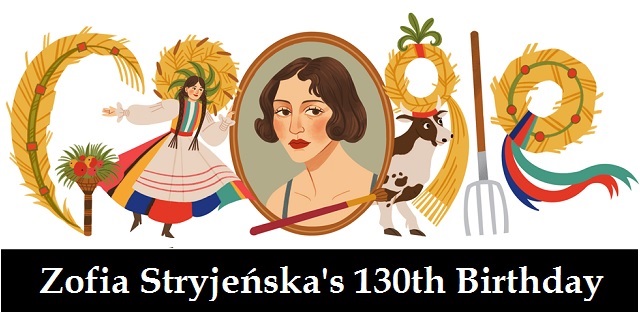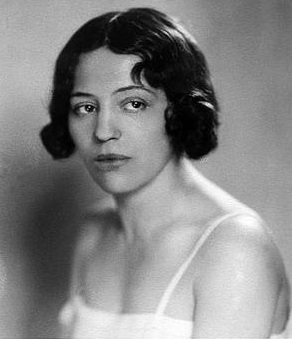Lifestyle
Google Doodle celebrates the 130th birthday of Zofia Stryjeńska, a Polish woman art deco artist

Google Doodle celebrates the 130th birthday of Polish painter Zofia Stryjeńska, one of the best-known Polish women art deco artists of the interwar period, on May 13, 2021.
Who was Zofia Stryjeńska?

Zofia Stryjeńska (Lubańska) on 13 May 1891 in Kraków, Grand Duchy of Kraków, Poland. She was a Polish painter, graphic designer, illustrator, stage designer, a representative of art deco.
Zofia Stryjeńska started painting exaggerations of her father’s clients in his glove shop, building up an ability that became her life’s passion. As a kid, she frequently drew and painted. She first attended a craft school, at that point a teacher’s seminary, and until 1909 Leonard Stroynowski’s private art school.
In 1909, Zofia Stryjeńska began to study painting at the Maria Niedzielska fine art school for women. She graduated in 1911 with honors for painting and applied art. In 1910 she joined her dad out traveling to Italy through Austria-Hungary, during which they visited exhibitions and museums in Vienna and Venice. As a young girl, she worked for magazines, for example, “Role” and “Voice of the People.”
Be that as it may, gender barriers stood in the way of her artistic interests; barriers she was determined to break. On October 1, 1911, she was admitted to the Academy of Fine Arts, Munich where just 40 of around 200 candidates were taken.
Zofia Stryjeńska used the name of her brother, Tadeusz Grzymala Lubański, and dressed like a boy because, at that time, the academy didn’t accept women. Stryjeńska trim her hair and went to the university disguised as a man. However, after a year in Munich, the pressure of keeping her identity hidden pushed her to get back to Kraków.
Zofia Stryjeńska returned to Kraków, where she dealt with painting and literature. Inspired by the history of her national identity, Stryjeńska started her career at 21 with a series of paintings dependent on Polish folklore.
Zofia Stryjeńska’s first artistic achievement came in 1912 when the Kraków Society of Friends of Fine Art included 18 of her watercolor representations of Polish Fables in its exhibition.
This modern take on a traditional work of art became her trademark; a style that acquired popularity as Poland had recently regained its independence in 1911 and its residents valued their historical iconography.
Zofia Stryjeńska’s 1917 series of surrealist lithographs named “Bożki Słowiańskie” (“Slavic Idols”) saw huge achievement and was printed on everything from postcards to chocolates.
She made part of the decoration of the Polish pavilion at the Exposition Internationale des Arts Decoratifs et Industriels Modernes in Paris in 1925, a series of six paintings for a year, showing rural village life and seasonal change. This work brought her Europe-wide fame and five World Trade awards. She made a series of paintings portraying Polish folk dance artists in 1927.
A specialist of folk costumes and Slavic mythology, Zofia Stryjeńska expressed the love of her heritage in work that went from wooden chess pieces to ballet costumes, similar to those intended for the 1930s Polish ballet “Harnasie.”
In 1930 the Literature gave Zofia Stryjeńska’s its highest award, Polonia Restituta. in 1936 the Polish Academy of Literature awarded her the Gold Academic Wreath for her contribution to Polish art in general.
Zofia Stryjeńska spent the second world war in Kraków. In 1943 she found she had syphilis, which influenced her eyes so that on occasion she was unable to paint. At the start of 1945, the Russians entered the city, founding a communist regime. Stryjeńska decided to leave Poland. She joined her children in Geneva.
After numerous years in Paris, she settled in Geneva, where her daughter and her sons lived. She attempted to go to the U.S., looking for help from the Kosciuszko Foundation. In any case, the Board of the Foundation dismissed her. She kept on living modestly in Geneva, helped by her children.
Zofia Stryjeńska remained emotionally associated with Poland and the Polish culture, Switzerland stayed a foreign country to her. She died in 1976 in Geneva, Switzerland, and was buried in the local Chêne-Bourg cemetery.
Stryjeńska was part of the art group “Rytm” (rhythm). She may likewise have been affected by Young Poland (Młoda Polska), an stylistically diverse art movement active somewhere in the range of 1890 and 1918.
Zofia Stryjeńska essentially used the tempera technique, creating lithographs, drawings, posters, designing toys, tapestry, stage sets, stage costumes, and making book illustrations.
She made part of the decoration of the Polish pavilion at the Exposition Internationale des Arts Decoratifs et Industriels Modernes in Paris in 1925, a series of six paintings for a year, showing rural village life and seasonal change. This work brought her Europe-wide publicity and five World Trade awards. She made a series of paintings representing Polish folk dance artists in 1927.
In numerous works, Zofia Stryjeńska describing the pre-Christian Slavic gods worshipped in Poland. Notwithstanding, the artist herself always viewed herself as a Christian. However, she was raised as a Catholic, but changed over for a brief timeframe to the Evangelical Church to divorce and remarry. Her interest in the beliefs of antiquated Slavs ought to be viewed as an artistic interest only.
Zofia Stryjeńska wanted to give her children a good education. She wrote a handbook on the etiquette of her time, using the pen name “Professor Hilar”. Her memoir Bread Almost Every Day was published in 1995. Her writing is characterized by free-flowing language and a rich vocabulary.
Among her most popular works are: pastorale, Slavic Idols cycle, and Passover, as well as illustrations of the poem “Monachomachii” by bishop Krasicki, Seasons, Christmas Carols, Four Polish Dances, and the sacraments.
On May 13, 2021, Google observes Zofia Stryjeńska’s 130th Birthday with Google Doodle.
Today’s Google Doodle artwork is represented by Poland-based guest artist Dixie Leota. Zofia Stryjeńska’s bold and adventurous work mirrors her character as a solid champion of creativity and artistic expression.
-

 Business3 weeks ago
Business3 weeks agoPrakash and Kamal Hinduja: Driving Social and Environmental Change
-
Education4 weeks ago
Fred DuVal: University Leadership as a Critical Resource for Climate Change Research and Life-Saving Solutions
-

 Cryptocurrency4 weeks ago
Cryptocurrency4 weeks agoDesigned For The Masses: How Akasha (AK1111) Is Unlocking Crypto For The Next Billion Users
-

 Health3 weeks ago
Health3 weeks agoThe Hinduja Brothers Commitment to Global Health: Empowering Communities Across Borders
-

 Cryptocurrency4 weeks ago
Cryptocurrency4 weeks agoNexaglobal & Future World Token (FWT): Could This Be the Next Big Crypto Investment of 2025?
-

 Startup20 hours ago
Startup20 hours agoSmall Business Month Encourages Entrepreneurs to Take Stock and Scale Up with Actionable Marketing Strategies
-

 Startup2 weeks ago
Startup2 weeks agoCost-Saving Strategies Every Small Business Owner Should Know to Boost Efficiency
-

 Startup3 weeks ago
Startup3 weeks agoMatthew Denegre on the Art of Deal Sourcing: Finding the Right Investment Opportunities























